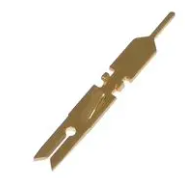I'm here after spending a several hours at https://connectorbook.com/ and while I learned some terms that describe my mystery connector, I haven't been able to determine a make and model. I hoping y'all can directly identify this connector or add more details that I might use in my search.
From The Electronic Connector Book, I learned that this connector would probably be categorized as board-to-board or single-wall one-row, but I haven't found any images that match yet.
Perhaps the most unique trait is how the connectors make contact -- it's like an edge cross lap joint in woodworking. Anyway, here are measurements and photos. Please let me know whether you want more information.
Measurements
- application: English industrial motor controller from the late 80s
- 32 contacts
- one row
- 2.54 mm pitch
- one wall
- no bumps or latches
- 101.6 mm long
- 17 mm wide
- 7.4 mm tall
- 88.5 mm spacing for top-facing mounting holes
- 95.2 mm spacing for front-facing mounting holes
Photos
The pins are spade-shaped with a slot down the center. The two connectors press together with the spades rotated 90 degrees from each other.






